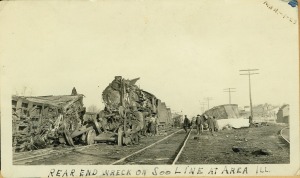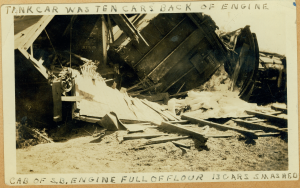In the early 1920s Lake County was witness to several horrible train accidents on the Soo Line. The Soo Line was part of the Canadian Pacific Railway and ran through western Canada and much of the Midwest, including downtown Mundelein. While the railroad helped bring prosperity and supplies to the area, it also brought tragedy. With heavy machinery moving at a high rate of speed, a train wreck could be quite catastrophic. Here are the stories of two train accidents which led to injuries, death, and destruction. In both cases it was human error, not system or mechanical failure, were to blame.
In March 1923, a train on the Soo Line heading west through Area (now Mundelein) had stopped, waiting to get orders to proceed. Strangely, a flagman was not sent to warn oncoming trains of the train stopped ahead. To make matters worse, the train had stopped on a part of the track that was somewhat obscured from view from any train approaching from the east. It wasn’t long before another train did in fact come along. The approaching train’s conductor didn’t see the stopped train until it was too late. The conductor, the engineer and the brakeman all jumped from the swiftly moving train when it became apparent that a collision was inevitable. The engineer and the conductor survived relatively unscathed, with minor cuts and bruises. Unfortunately the brakeman, Frank Herbert, wasn’t so lucky. He suffered a severely broken leg along with several bumps and bruises. Initial reports feared that Herbert’s broken leg was a possible life-threatening injury; however, Herbert recovered enough after being treated by Dr. Martin of Libertyville to return home to Fond du Lac, Wisconsin.
The wreckage was a sight to behold: 16 cars had been tossed across the area from the impact of the collision, creating about 400 feet of debris. The moving train had been traveling at about 35 mph. This explains why the crew of the train didn’t jump until they had to, as leaping from a fast moving train was an only slightly better option than being on one when it rammed another. A fire started from a stove that had overturned in the caboose when it was hit by the oncoming engine. The Area fire department was called and quickly put out the blaze. The collision caused several hours’ delay to the railroad schedule while wreckage was removed from the accident site.
In August of 1925, the Soo Line saw an even worse wreck, this time just outside of Grayslake. A northbound train was stopped to give a southbound train approaching room to pass. However, the northbound train was positioned in such a way as to not leave enough room for the clearance of the oncoming train. As the southbound train approached down the opposite track heading for Chicago at about 30 to 35 mph, Edward Mulligan, fireman for the southbound train, saw the train and realized that a collision was imminent. He then warned the engineer, Arthur Davis, and both proceeded to jump from the moving train. When the two trains collided, momentum sent both of them into a ditch. The trains were loaded with grain, oats and other goods, which were scattered in every direction. Arthur Davis fractured his leg and the train’s brakeman, Arthur Mayround, broke his arm. Both men received prompt medical attention and were sent home. Sadly Edward Mulligan, the one who warned the others of the impending crash, was killed instantly when he hit the ground. He was found shortly after the crash with a fractured skull and broken neck.
Train traffic ground to a halt for about 12 hours after the crash while trains and material were moved off of the tracks. In total two engines and 13 cars were involved in the accident. At the point of the collision, debris was piled about 20 to 35 feet high. In an interesting note, none of the northbound train’s crew was hurt as they realized there was going to be a collision and were able to get away, since their train was already stopped.
Sources
“Canadian Pacific Limited.” International Directory of Company Histories. Ed. Adele Hast. Vol. 5. Chicago: St. James Press, 1992. 429-431. U.S. History in Context. Web. 25 Aug. 2015.
“Freight Trains in bad wreck at Area this noon. “ Libertyville Independent. Mar. 1, 1923, p. 1.
“Two Long Freights on Soo Line Pile Up; Brakeman Suffers Injuries Which May Prove Fatal.” Lake County Independent. March 1, 1923 p. 1.
“1 dead on Soo Ry. Saturday evening.” Libertyville Independent. August 27, 1925, p. 1, 4.
“One Killed; Two Hurt in Train Wreck.” Lake County Independent. August 27, 1925, p. 1.
Discover more from Cook Memorial Public Library District
Subscribe to get the latest posts sent to your email.
Categories: Local History





